The main conditions treated with proton therapy

Proton therapy is an effective option for treating cancer because it provides highly effective treatment while causing only mild physical side effects. At the same time, not all forms of cancer can be treated using proton therapy.
Please note that proton therapy can only be administered if all of the basic conditions described below apply. A specialist at this center will diagnose whether or not your condition is suited to receiving proton therapy on the basis of a comprehensive overview. If alternative treatments are more suitable for you due to the type and conditions of your disease, we will consult with specialists in the relevant field at our hospital to propose such treatments.
Basic conditions
- The tumor has not spread to any other organ in the body, and is limited to a small area.
- The patient has not already received radiation therapy on the part of the body where the proton therapy is to be applied.
- The patient can lie still in the same position for 30 minutes.
- The patient has been informed about his or her disease, and he or she wishes to receive proton therapy.
Liver cancerTreatment period: 2-7 weeks
The most common means of treating esophagus cancer is surgical removal of the tumor. However, in cases in which surgical procedures incur a high risk due to the age or clinical complications of the patient, radiation therapy combined with chemotherapy is a more suitable means of treatment. In this case, the radiation therapy can be provided in the form of proton therapy. The proton therapy can be effective in treating esophagus cancer while at the same time minimizing the side effects on other important organs such as the spinal cord, lungs or heart.
Pathological and other conditions for proton therapy
- There are no more than three tumors, and none of the tumors are in contact with the digestive tract.
- There are no tumors other than those in the liver.
- The liver functions are still intact to some extent.
Notes regarding treatment:
The patient may be requested to have a metal marker the size of a mechanical pencil lead inserted in his or her liver in order to allow the proton beam to be administered with a higher precision. The procedure to insert such a marker is arranged on the basis of consultation with the patient’s referring doctor and doctors from the relevant departments of our hospital.
Photos of the course of therapy
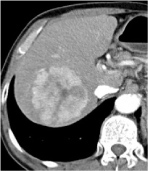 Before treatment
Before treatment
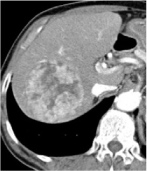 2 weeks after end
2 weeks after end
of treatment
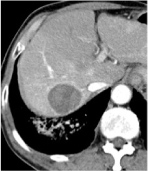 2.5 months after end
2.5 months after end
of treatment
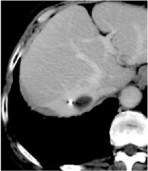 8.5 months after end
8.5 months after end
of treatment
→No relapse
Prostate cancer Treatment period: 5-8 weeks
The treatments for prostate cancer include surgery, radiation therapy, and hormone therapy. Treatment methods are decided on the basis of the results of blood tests, imaging examinations, and pathological examinations. Proton therapy is one of the most effective and safest treatments among the treatments using radiation. Proton therapy treatment methods can be arranged promptly if the patient first consults with his or her urology doctor about cancer treatments and brings the examination results (in particular, a biopsy tissue sample) to the initial proton therapy consultation.
Pathological and other conditions for proton therapy
- The cancer has not spread to other organs or lymph nodes.
- Cases of prostate cancer are classified as either low-risk, a medium-risk, or high-risk according to the condition of the tumor. For cases classified as low-risk, only proton therapy is administered, and in medium- and high-risk cases proton therapy is combined with hormone therapy.
Notes regarding treatment:
The patient may be requested to have a metal maker the size of a mechanical pencil lead inserted in his or her prostate gland in order to allow the proton beam to be administered with a higher precision. The procedure to insert such a marker is arranged on the basis of consultation with the patient’s referring doctor and doctors in the department of urology.
Lung cancer Treatment period: 2-7 weeks
There are a number of types of lung cancer which differ according to the form of the cancer cells. Patients with cases of stage I lung cancer, in which cancer cells are localized in a lung, may be treated using proton therapy as outpatients for a period of about two weeks. In cases of stage II and III lung cancer, in which cancer has spread to nearby lymph nodes, it is likely that proton therapy treatment will need to combined with chemotherapy, and be administered for six to seven weeks. In comparison with traditional radiation therapy, proton therapy has fewer side effects on the lung and bone marrow.
Pathological and other conditions for proton therapy
- The cancer is non-small cell lung cancer of stage I, II or III and has not spread to any other organs.
- In cases of stage I lung cancer, proton therapy is provided for patients who do not wish to or are unable to receive surgical treatment for some reason.
- In cases of stage II or III lung cancer, proton therapy is combined with treatment by anti-cancer medication, in cooperation with the department of respiratory medicine.
Notes regarding treatment:
No smoking is allowed during and after the treatment.
In cases in which chemotherapy is used alongside proton therapy, the patient may need to be hospitalized.
Photos of the course of therapy
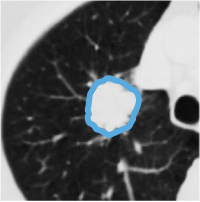 Before treatment
Before treatment
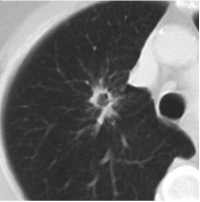 At the end of therapy
At the end of therapy
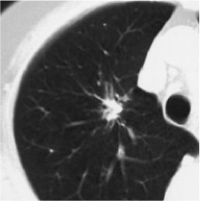 1 month after completion of therapy
1 month after completion of therapy
Esophagus cancer Treatment period: 6-7 weeks
The most common means of treating esophagus cancer is surgical removal of the tumor. However, in cases in which surgical procedures incur a high risk due to the age or clinical complications of the patient, radiation therapy combined with chemotherapy is a more suitable means of treatment. In this case, the radiation therapy can be provided in the form of proton therapy. The proton therapy can be effective in treating esophagus cancer while at the same time minimizing the side effects on other important organs such as the spinal cord, lungs or heart.
Pathological and other conditions for proton therapy
- The cancer has not spread to other internal organs.
- Treatment may take the form of chemoradiotherapy, which is a method combining proton therapy and anti-cancer medication.
- Proton therapy is not used in cases in which the cancer has spread to nearby lymph nodes such that the proton-beam irradiation field cannot fully cover the cancer spread.
Notes regarding treatment:
- Proton therapy is not used in cases in which the cancer has spread to nearby lymph nodes such that the proton-beam irradiation field cannot fully cover the cancer spread
- The patient may be requested to have a metal maker the size of a mechanical pencil lead inserted in his or her esophagus in order to allow the proton beam to be administered with a higher precision.
- In cases in which proton therapy is combined with chemotherapy, the treatment is provided in close cooperation with specialists in internal medicine and surgery of the digestive organs.
Photos of the course of therapy
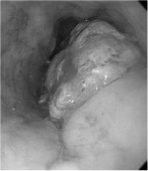 Before treatment
Before treatment
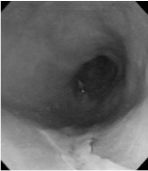 2 weeks after end of
2 weeks after end of
treatment
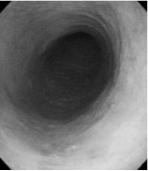 2.5 months after end
2.5 months after end
of treatment
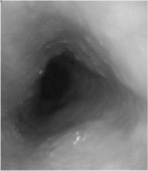 8.5 months after end
8.5 months after end
of treatment
→No relapse
Head and neck cancer Treatment period: 6-7 weeks
There are a number of types of head and neck cancer. Proton therapy is currently used for the treatment of nasal cavity cancer, paranasal sinus cancer, and external auditory canal cancer. It is most often used for the treatment of squamous cell carcinoma, but can also be administered for the treatment of adenocarcinoma and malignant melanoma. The actual method of treatment varies according to the location of the tumor, results of pathological tissue examinations, and the progress of the disease. A multidisciplinary treatment combining surgery, radiation treatment, and chemotherapy may be used for the treatment of these conditions.
Pathological and other conditions for proton therapy
- The cancer has not spread to other organs.
- The cancer has not spread to nearby lymph nodes, or, the whole tumor can be fully covered by a single irradiation field.
Notes regarding treatment:
The possible side effects differ depending on the size of a tumor. A detailed explanation of such effects will be given as part of consultations regarding treatment.
Brain tumor Treatment period: 5-6 weeks
Brain tumors can be classified as one of two types: primary tumors which occur inside the skull, and metastatic tumors which have been transferred from other organs. In suspected cases of brain tumors, diagnosis is carried out using imaging, such as MRI procedures using a contrast dye. In the case of suspected primary brain tumors, ultimately tumors are removed by surgery and the removed tissue is examined and used to decide treatment strategies.
Pathological and other conditions for proton therapy
- Proton therapy may be used to treat primary brain tumors, such as malignant glioma, and meningioma and schwannoma which are difficult to remove by surgery.
- Proton therapy is not used to treat metastatic brain tumors because it is possible to use other radiation therapies.
Notes regarding treatment:
When treating brain tumors with proton therapy, care is taken to ensure that as far as possible the proton beam is emitted in directions along which it is unlikely to come into contact with optic nerves or the brain stem. Proton therapy may not be suitable in some cases depending on the patient’s condition.
Skull base tumor Treatment period: 5-6 weeks
Skull base tumors occur in the portion of the skull supporting the brain. These tumors lie deep inside the skull, and in many cases, are attached to or fused with a number of important nerves or major blood vessels, making surgical treatment very difficult. Specific examples of such conditions include chordoma and chondrosarcoma. In some cases, cancer that occurs in the nasal cavity, paranasal sinus, or eye sockets may develop into skull base tumors.
Pathological and other conditions for proton therapy
- Proton therapy is used in cases in which surgery cannot be used or in which tumors cannot be fully removed by surgery.
Notes regarding treatment:
When treating skull base tumors with proton therapy, care is taken to ensure that as far as possible the proton beam is emitted in directions along which it is unlikely to come into contact with optic nerves or the brain stem. As the treatment is applied to an area containing a dense concentration of important nerves and organs, a detailed explanation will be given as part of consultations regarding treatment.
Childhood cancer Treatment period: 2-6 weeks
Children are susceptible to the effects of radiation. If children receive more than a certain amount of radiation dose, there may be adverse effects on their bone growth, intellectual development, or endocrine functions. In some cases, long after the childhood cancer has been completely cured through radiation therapy, a new cancer, known as a secondary cancer, may occur, and it is thought that such secondary cancers may be a side-effect of the radiation therapy. Proton therapy can limit the risk of such complications by minimizing the exposure of healthy tissue to radiation.
Pathological and other conditions for proton therapy
- Proton therapy is used to treat childhood solid tumors which need radiation therapy. We may propose other radiation therapies according to the medical condition of the patient.
Notes regarding treatment:
As it is necessary to combine this therapy with chemotherapy and surgery, please consult with your family doctor first. It is important that therapy is provided at the right timing, so please seek consultation as soon as possible.

